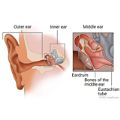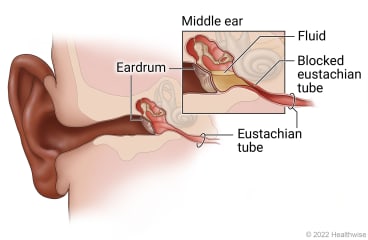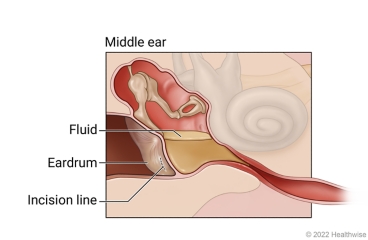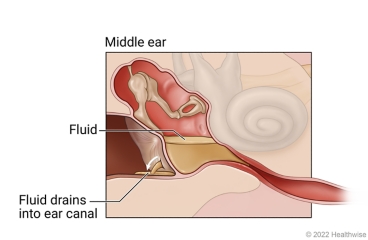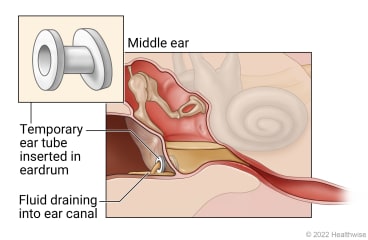Women’s Health Library
Our Health Library information does not replace the advice of a doctor. Please be advised that this information is made available to assist our patients to learn more about their health. Our providers may not see and/or treat all topics found herein.
Ear Tube Surgery
Surgery Overview
Ear tubes are plastic and shaped like a hollow spool. Doctors suggest tubes for children who have repeat ear infections or when fluid stays behind the eardrum. A specialist (otolaryngologist) places the tubes through a small surgical opening made in the eardrum (myringotomy or tympanostomy). The child is unconscious under general anesthesia for this surgery.
Tubes can help with ear infections because they:
- Allow air to enter the middle ear.
- Allow fluid to flow out of the middle ear through the tube into the ear canal.
- Clear the fluid from the middle ear and restore hearing.
- Prevent future buildup of fluid in the middle ear while they are in place.
- Decrease the feeling of pressure in the ears, which reduces pain.
How Its Done
Fluid buildup in the middle ear
slide 1 of 4
slide 1 of 4, Fluid buildup in the middle ear,
A cold or some other upper respiratory infection can cause the eustachian tubes to swell, blocking the normal drainage from the middle ear. The fluid buildup can lower your or your child's ability to hear. And the warm, moist environment makes it easy for bacteria and viruses to grow, causing an ear infection.
Incision made in the eardrum
slide 2 of 4
slide 2 of 4, Incision made in the eardrum,
A small cut (incision) is made in the eardrum to allow fluid to drain.
Fluid drains through the incision
slide 3 of 4
slide 3 of 4, Fluid drains through the incision,
Fluid from the middle ear drains through the incision into the ear canal and is suctioned out by the doctor.
Ear tube placed
slide 4 of 4
slide 4 of 4, Ear tube placed,
The temporary tube is placed into the eardrum incision to prevent fluid from building up again.
What To Expect
Tubes can be inserted in an outpatient surgery clinic. Children usually recover quickly and have little pain or other symptoms after surgery. Most children go home within 1 to 2 hours after the surgery. Your child will probably be able to go back to school or child care the next day.
Follow-up visits to the doctor are very important. The doctor checks to see if the tubes are working and if the child's hearing has improved.
Ask the doctor if your child needs to take extra care to keep water from getting in the ears when bathing or swimming. Your child may need to wear earplugs. Find out what your doctor recommends.
Tubes normally stay in the ears for 6 to 18 months. They often fall out on their own. After the tubes are out, watch your child for signs of ear infection or fluid behind the eardrum.
Why It Is Done
Placing tubes in the ears drains the fluid and ventilates the middle ear. Tubes may keep ear infections from recurring while the tubes are in place. They keep fluid from building up behind the eardrum. And they decrease the feeling of pressure in the ears, which reduces pain. Doctors consider surgery to insert tubes:
- If a child has fluid buildup in the ears for 3 to 4 months, especially if they have some hearing loss.
- If a child has repeat ear infections.
How Well It Works
Ear tube surgery works well to release blocked fluid and to prevent buildup of pressure and fluid in the middle ear. This can help a child hear better.
Tubes may prevent some ear infections. And if a child who has ear tubes gets an ear infection, they will usually have less pain.
Risks
Possible problems include:
- Drainage from the ear (otorrhea). It can become an ongoing problem in some children.
- Damage to the eardrum over time. These changes in the eardrum may affect hearing in a small number of children.
- The tube may become blocked. This can allow ear fluid and infections to return.
- The tube may slip out of place, possibly falling into the middle ear. This is rare.
- Tissue may form behind the eardrum (cholesteatoma). This is also rare.
Credits
Current as of: October 27, 2024
Current as of: October 27, 2024


